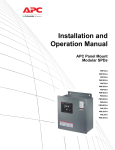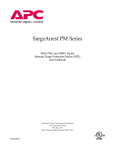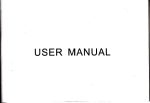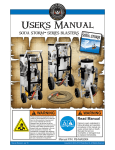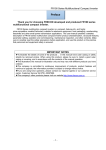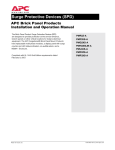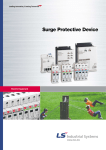Download APC SURGEARREST PMF3S-A Instruction manual
Transcript
Surge Protective Devices (SPD) APC Modular Panel Products Installation and Operation Manual The APC Modular Panel Product Surge Protective Devices (SPD) are designed to provide protection at the service entrance, branch panels or other critical locations for today’s electrical equipment. The APC SurgeArrest® Modular Panel Mount Products have replaceable phase modules with integrated LED monitoring, a display panel with surge counter and LED status indicators, an audible alarm, and a NEMA 3R/12 Enclosure. Modular Panel Products are available with 120kA and 160kA maximum surge current per phase ratings. PMF3S-A PMF3DS-A PMF4S-A PMF4DS-A PMG3S-A PMG3DS-A Compliant with UL 1449 2nd Edition requirements dated February 9, 2007. PMG4S-A PMG4DS-A PMH4DSLM-A PML3S-A PML3DS-A PML4S-A PML4DS-A PML-4Y-DC-DL-A PMP3S-A PMP3DS-A PMP4S-A PMP4DS-A Retain for future use 1-800-800-4272 | www.apc.com WARNINGS APC MODULAR PANEL PRODUCTS Surge Protective Device (SPD) DANGER HAZARD OF ELECTRIC SHOCK, EXPLOSION, OR ARC FLASH · Apply appropriate personal protective equipment (PPE) and follow safe electrical work practices. See NFPA 70E. · This equipment must only be installed and serviced by qualified electrical personnel. · Turn off all power supplying this equipment before working on or inside equipment. · Always use a properly rated voltage sensing device to confirm power is off. · Replace all devices, doors and covers before turning on power to this equipment. Failure to follow these instructions will result in death or serious injury. CAUTION LOSS OF BRANCH CIRCUIT POWER AND SURGE PROTECTION In the event that the surge protective elements of the SPD have been damaged (i.e. excessive surge energy, power system anomaly, etc.), the surge protective elements can lose their ability to block power system voltage and attempt to draw excessive current from the line. This SPD is equipped with overcurrent and overtemperature protection that will automatically disconnect the surge protective elements from the mains should the surge protective elements be damaged. The effects of damaged surge protective elements and the subsequent operation of the automatic overcurrent and overtemperature protection must be considered when applying a SPD, particularly when critical loads requiring continuity of power or continuity of surge protection are present on the power system. The following items should be considered when applying a SPD: · Tripping of the branch circuit breaker feeding the SPD can occur when the surge protective elements are damaged. Do not connect the SPD to a branch circuit feeding a load requiring continuity of power (i.e. central computer or control systems, safety-critical equipment, critical processes or systems, etc.) unless the branch circuit breaker trip characteristic has been coordinated with the overcurrent protection inside the SPD. · Periodic inspection of the state of the status indicator lights on the SPD should be made as part of the preventive maintenance schedule. The SPD should be promptly serviced when an alarm state exists. · For unmanned, inaccessible, or critical installations, the dry contacts should be used to signal an alarm state to the central supervisory system. · In addition to the preceding items, the use of multiple SPD’s to achieve redundancy should be considered for critical applications. Failure to follow these instructions can result in loss of power or loss of surge protection that can cause injury or equipment damage. 2 APC MODULAR PANEL PRODUCTS Surge Protective Device (SPD) WARNINGS CAUTION LOSS OF SURGE PROTECTION · During installation into an electrical system, SPD’s must not be energized until the electrical system is completely installed, inspected, and tested. All conductors must be connected and functional, including the neutral. The voltage rating of the device and system must always be verified before energizing the surge protective device. · Any factory or on-site testing of power distribution equipment that exceeds the normal operating voltage, such as high-potential insulation testing, or any other tests where the suppression components will be subjected to voltages higher than their rated turn-on voltage must be performed with the suppressor disconnected from the power source. The neutral connection at the SPD must also be disconnected prior to performing high-potential testing and then reconnected upon completion of the test. Failure to follow these instructions can result in loss of power or loss of surge protection that can cause injury or equipment damage. IMPORTANT! Electrical equipment should be installed, operated, serviced, and maintained only by qualified personnel. No responsibility is assumed by APC for any consequences arising out of the use of this material. 3 TABLE OF CONTENTS APC MODULAR PANEL PRODUCTS Surge Protective Device (SPD) SurgeArrest® Modular PM Series CONTENTS INTRODUCTION .............................................................................. 5 UNPACKING AND PRELIMINARY INSPECTION ............................... 6 STORAGE ........................................................................................ 6 IDENTIFICATION NAMEPLATE ......................................................... 7 SAFETY LABELS ............................................................................. 7 SPD LOCATION CONSIDERATIONS ................................................ 7 Environment .............................................................................. 7 Audible Noise............................................................................. 7 Mounting ................................................................................... 7 Service Clearance ...................................................................... 7 Equipment Performance ............................................................ 7 ELECTRICAL ................................................................................... 8 Service Voltage / Model Numbers ............................................ 8 Terminals, Wire Size and Installation Torque ............................. 9 Disconnect Means ................................................................... 9 Integral Disconnect ..................................................................10 Location of SPD ......................................................................10 SYSTEM GROUNDING ....................................................................10 INSTALLATION ............................................................................... 11 Conduit Location and Recommendations .................................11 Special Enclosure Considerations ............................................ 11 Removing and Reconnecting the Patch Cables ........................ 11 NEMA 3R Applications ............................................................ 11 WIRING ........................................................................................12 Wiring Diagrams without Integral Disconnect ............................13 Wiring Diagrams with Integral Disconnect ................................ 14 OPERATION ...................................................................................15 LED Status Indicators ..............................................................15 Audible Alarm ..........................................................................16 Surge Counter ........................................................................16 Dry Contacts ...........................................................................17 Remote Monitor Option ........................................................... 17 MAINTENANCE AND TROUBLESHOOTING ................................... 18 Preventive Maintenance .......................................................... 18 Troubleshooting ....................................................................... 19 Replacement Parts .................................................................. 19 WARRANTY.................................................................................... 19 CUSTOMER SUPPORT.................................................................. 20 4 APC MODULAR PANEL PRODUCTS Surge Protective Device (SPD) INTRODUCTION INTRODUCTION Thank you for choosing the APC SurgeArrest® PM3 or PM4 Series Surge Protection Device. The APC modular Surge Protection Device (SPD) is a high-quality, high-energy surge attenuation system that has been designed to protect sensitive equipment from damaging transient voltage surges. Proper installation is imperative to maximize the surge suppressor’s effectiveness and performance. This manual is to be used as a guide for installing the device. Read and understand all information contained in this manual prior to installation. The outlined procedures are not intended to supersede local or national electrical codes. Check all applicable electrical codes to assure compliance. This device must be installed by a licensed electrician. The electrician should follow the steps detailed in this manual to ensure proper installation. A copy of the installer’s invoice, detailing the installation of this device, is required in order to take advantage of the unit’s product warranty. The SurgeArrest® PM3 and PM4 Series modular product lines specify a parallel SPD designed for service entrance and downstream panelboard applications. These units provide replaceable module surge protection and are available with 120kA and 160kA per phase ratings, respectively. All APC products are extensively tested according to industry standards as set by IEEE C62.41 and C62.45 for Categories A, B, and C. The connection method for these devices may require several feet of wire. Be aware that increased lead length adversely affects clamping voltages. Save this manual! It includes instructions regarding the product warranty and replacement parts. Testing Any factory or on-site testing that exceeds the normal operating voltage, such as high-potential insulation testing or other tests where the suppression components will be subjected to voltages higher than their rated "turn on" voltage, must be run with the suppressor disconnected from the power source. For 4-wire TVSS devices, the neutral connection at the TVSS must also be disconnected prior to performing high-potential testing and then reconnected upon completion of the test. Failure to disconnect this surge suppression device and its associated suppression components during elevated voltage testing will result in damage to the suppression components and/or other electronic components. 5 PACKAGING APC MODULAR PANEL PRODUCTS Surge Protective Device (SPD) DANGER HAZARD OF ELECTRIC SHOCK, EXPLOSION, OR ARC FLASH · Apply appropriate personal protective equipment (PPE) and follow safe electrical work practices. See NFPA 70E. · This equipment must only be installed and serviced by qualified electrical personnel. · Turn off all power supplying this equipment before working on or inside equipment. · Always use a properly rated voltage sensing device to confirm power is off. · Replace all devices, doors and covers before turning on power to this equipment. Failure to follow these instructions will result in death or serious injury. UNPACKING AND PRELIMINARY INSPECTION Proper installation is imperative to maximize the APC Modular Panel SPD’s effectiveness and performance. The installer should follow the steps outlined in this instruction manual to ensure proper installation. Read the entire instruction manual before beginning the installation. These instructions are not intended to replace national or local electrical codes. Check all applicable electrical codes to verify compliance. Installation of surge suppressors should only be performed by qualified electrical personnel. NOTE: SPD 's are designed for use on the load side of the service entrance disconnect only. Inspect the entire shipping container for damage or signs of mishandling before unpacking the device. Remove the packing material and further inspect the device for any obvious shipping damage. If any damage is found and is a result of shipping or handling, immediately file a claim with the shipping company. STORAGE 6 The device should be stored in a clean, dry environment. Storage temperature is -40 to +65 °C (-40 to +149 °F). All of the packaging materials should be left intact until the device is ready for installation. APC MODULAR PANEL PRODUCTS Surge Protective Device (SPD) IDENTIFICATION NAMEPLATE IDENTIFICATION The identification nameplate (see Figure 1) is located on the inside of the door/cover. Figure 1: SPD Nameplate Example SAFETY LABELS English versions of all safety labels (danger, warning, caution) are provided. SPD LOCATION CONSIDERATIONS Environment Audible Noise Mounting Service Clearance Equipment Performance The device is designed to operate in an ambient temperature range of -40 to +65 °C (-40 to +149 °F) with a relative humidity of 0 to 95% noncondensing. Refer to the product catalog for further details on enclosures. All SPD’s operate normally without reduction in performance when subjected to shock and vibrations described in IEC 60721-3-3, Class 3M4. The device background noise is negligible and does not restrict the location of the installation. This device is designed to be surface mounted. Refer to the device submittal drawings or the product catalog for typical mounting dimensions and weight. Install the APC Modular Panel SPD in a restricted access area. The service clearance should meet all applicable code requirements. To obtain the maximum system performance, locate the device as close as possible to the circuit breaker to minimize the interconnecting wiring length. For every foot in length of wire, approximately 175 volts per foot (6 kV/ 3 kA, 8/20 microsecond) is added to the suppressed voltage. The suppressed voltage rating is located on the device nameplate and is measured 6 inches from the device terminals, according to UL® 1449 Second Edition. 7 ELECTRICAL APC MODULAR PANEL PRODUCTS Surge Protective Device (SPD) ELECTRICAL Voltage Rating Prior to mounting the SPD, verify that the device has the same voltage rating as the power distribution system in which it is installed by comparing the nameplate voltage or model number on the SPD with the nameplate of the electrical distribution equipment. The specifier or user of the device should be familiar with the configuration and arrangement of the power distribution system in which any SPD is to be installed. The system configuration of any power distribution system is based strictly on how the secondary windings of the transformer supplying the service entrance main or load are configured. This includes whether or not the transformer windings are referenced to earth via a grounding conductor. The system configuration is not based on how any specific load or equipment is connected to a particular power distribution system. See Table 1 for the service voltage of each SPD. Table 1: APC Modular Panel SPD Voltage Ratings/Model Number Service voltage configuration 120/208 wye 3Ph. Wye 4-wire +G 120kA PMF3S-A 120/208 wye 3Ph. Wye 4-wire +G 120kA PMF3DS-A 120/240 wye (Single Phase) 1Ph. Wye 3-wire +G 120kA PMP3S-A 120/240 wye (Single Phase) 1Ph. Wye 3-wire +G 120kA PMP3DS-A 277/480 wye 3Ph. Wye 4-wire +G 120kA PMG3S-A ka rating MoDel nuMBer 277/480 wye 3Ph. Wye 4-wire +G 120kA PMG3DS-A 347/600 wye 3Ph. Wye 4-wire +G 120kA PML3S-A 347/600 wye 3Ph. Wye 4-wire +G 120kA PML3DS-A 120/208 wye 3Ph. Wye 4-wire +G 160kA PMF4S-A 120/208 wye 3Ph. Wye 4-wire +G 160kA PMF4DS-A 120/240 wye (Single Phase) 1Ph. Wye 3-wire +G 160kA PMP4S-A 120/240 wye (Single Phase) 1Ph. Wye 3-wire +G 160kA PMP4DS-A 220/380 wye 3Ph. Wye 4-wire +G 160kA PMH4DSLM-A 277/480 wye 3Ph. Wye 4-wire +G 160kA PMG4S-A 277/480 wye 3Ph. Wye 4-wire +G 160kA PMG4DS-A 347/600 wye 3Ph. Wye 4-wire +G 160kA PML4S-A 347/600 wye 3Ph. Wye 4-wire +G 160kA PML4DS-A 347/600 wye 3Ph. Wye 4-wire +G 160kA * PML-4Y-DC-DL-A * Redundant 160kA system Terminals, Wire Size and Installation Torque Terminals are provided for phase (line), neutral, and equipment ground connections. The SPD terminals accept a range of #12 to #2 AWG (34 mm2) copper wire for phase, neutral, and ground connectors. Torque connections to the following values. Table 2: Installation Torque Power Connection AØ, BØ, CØ & N Ground Disconnect Means (External) 8 Terminal Torque W/O Disconnect W/ Disconnect 35 lb-in (4N·M) 50 lb-in (5.7N·M) 50 lb-in (5.7N·M) The use of fusible disconnects requires a fuse with a melting characteristic greater than the per phase (Clearing) I2t of the SPD to prevent nuisance operation of the disconnect fuses during a surge. (Refer to caution statement “LOSS OF BRANCH CIRCUIT POWER AND SURGE PROTECTION” on page 2 for further information) ELECTRICAL APC MODULAR PANEL PRODUCTS Surge Protective Device (SPD) WARNING UNDERSIZED WIRING (USE ONLY CONDUCTORS RATED 30 A OR GREATER.) · The SPD is designed for connection to a 30 A (or greater) circuit breaker. · The circuit breaker is the intended disconnect means for the SPD without integral disconnect option and provides over current protection for the connecting conductors. · The circuit breaker maximum rating should not exceed the ampacity of the connecting conductors. Failure to follow these instructions can result in death or serious injury. Turn off all power supplying this equipment through the Panel Circuit Breaker or Primary Disconnect before working on or inside the equipment. INTEGRAL SWITCH The integral switch is a second mechanical means for qualified maintenance personnel to isolate the entire surge suppressor to service the device’s components. The integral switch opens the phase and neutral connections to the SPD for additional protection. Turn integral switch handle to the OFF position prior to opening the door of the unit. With the handle in the OFF position, the SPD will be disconnected from the circuit and the circuit will not be protected from surges. Maintenance may now be performed on the SPD modules and associated parts. Upon completion of repairs, close the door of the unit and turn the handle to the ON position. Close the Panel Circuit Breaker or Primary Disconnect to power SPD. LOCATION OF SPD Install SPD’s on the load side of the main overcurrent protection to comply with UL 1449 and the NEC. Locate the SPD as close as possible to the circuit breaker being protected to minimize the wire length and optimize SPD performance. Avoid long wire runs so that the device will perform as intended. To reduce the impedance that the wire displays to surge currents, the phase, neutral, and ground conductors must be routed within the same conduit and tightly bundled or twisted together to optimize device performance. Avoid sharp bends in the conductors. See Figure 2. Figure 2: Wiring Practice To "protected" load(s) SPD Phase A Phase B Phases Neutral Ground Phase C Neutral bus Ground bus Neutral Ground Interconnect wiring - Minimize length - Avoid sharp bends 9 ELECTRICAL SYSTEM GROUNDING APC MODULAR PANEL PRODUCTS Surge Protective Device (SPD) CAUTION SYSTEM GROUNDING · SPD must be installed on solidly grounded power systems. · Verify that the service entrance equipment is bonded to ground in accordance with all applicable codes. · Verify that the neutral terminals are grounded to system ground in accordance with all applicable codes. Failure to follow these instructions can result in equipment damage. An equipment ground conductor must be used on all electrical circuits connected to the SPD. For the best performance, use a single-point ground system where the service entrance grounding electrode system is connected to and bonded to all other available electrodes, building steel, metal water pipes, driven rods, etc. (for reference, see IEEE STD 142-1991). The ground impedance measurement of the electrical system should be as low as possible, and in compliance with all applicable codes, for electronics and computer systems. When metallic raceway is used as an additional grounding conductor, an insulated grounding conductor should be run inside the raceway and sized in accordance with all applicable codes. WARNING INADEQUATE RACEWAY ELECTRICAL CONTINUITY · Ground impedance must be as low as possible and in compliance with all applicable codes for electronic and computer systems. · Install an insulated grounding conductor inside a metallic raceway when the raceway is used as an additional grounding conductor. Size the conductor in accordance with all applicable codes. · Maintain adequate electrical continuity at all raceway connections. · Do not use isolating bushings to interrupt a metallic raceway run. · Do not use a separate isolated ground for the SPD. · Verify proper equipment connections to the grounding system. · Verify ground grid continuity by inspections and testing as part of a comprehensive electrical maintenance program. Failure to follow these instructions can result in death or serious injury. 10 APC MODULAR PANEL PRODUCTS Surge Protective Device (SPD) INSTALLATION INSTALLATION DANGER HAZARD OF ELECTRIC SHOCK, EXPLOSION, OR ARC FLASH · Apply appropriate personal protective equipment (PPE) and follow safe electrical work practices. See NFPA 70E. · This equipment must only be installed and serviced by qualified electrical personnel. · Turn off all power supplying this equipment before working on or inside equipment. · Always use a properly rated voltage sensing device to confirm power is off. · Replace all devices, doors and covers before turning on power to this equipment. Failure to follow these instructions will result in death or serious injury. CONDUIT LOCATION AND RECOMMENDATIONS The recommended conduit entry is at the bottom of the device enclosure. Use a conduit seal that is appropriate for the enclosure rating. SPECIAL ENCLOSURE CONSIDERATIONS Removing and Reconnecting the Communication Patch Cables The communication patch cables are marked with matching phase connections. If any of the cables are removed, reconnect the cables as marked. NEMA 3R Applications Remove screws from the bottom of the enclosure to create drain holes. Mounting Recommendation Locate the SPD as close as physically possible to the node/equipment to be protected, thereby limiting lead length and ensuring lower let through voltages on the protected equipment. For every foot of wire length, approximately 1 nanosecond of turn-on/turn-off time will be added, and approximately 175 volts (6kV/3kA,8/20 microseconds) will be added to the clamping voltage. 11 WIRING APC MODULAR PANEL PRODUCTS Surge Protective Device (SPD) DANGER HAZARD OF ELECTRIC SHOCK, EXPLOSION, OR ARC FLASH · Apply appropriate personal protective equipment (PPE) and follow safe electrical work practices. See NFPA 70E. · This equipment must only be installed and serviced by qualified electrical personnel. · Turn off all power supplying this equipment before working on or inside equipment. · Always use a properly rated voltage sensing device to confirm power is off. · Replace all devices, doors and covers before turning on power to this equipment. Failure to follow these instructions will result in death or serious injury. WIRING Note: Prior to mounting the SPD, verify that the device has the same voltage rating as the power distribution system in which it is installed by comparing the nameplate voltage or model number on the SPD with the nameplate of the electrical distribution equipment. Follow steps 1–5 to make wiring connections. 1. Turn off all power supplying this equipment through the Panel Circuit Breaker or Primary Disconnect before working on or inside the equipment. (For additional protection, an integral switch may be used) 2. Mount the SPD as close as possible to the panelboard being protected. 3. Connect the SPD to the panelboard using an approved wiring method. The connecting wires should be twisted (1/2 turn for each foot of length) together and kept as short as possible (do not loop or coil wires) to enhance the performance of the device. See page 8 for the recommended wire size and installation torque. For wiring diagrams, see figures 3 thru 6. a. Connect the ground wire to the GROUND bus of the distribution panel. Where applicable, connect ground to the SPD module. b. Where applicable, connect the neutral wire to the SPD module. c. Be sure the circuit breaker is open (OFF) prior to making any connections of any kind. If a circuit breaker or circuit breaker space is not available, connect to the electrical panel bus and then to an integral disconnect utilizing the 3M or 10ft tap rule. (See NEC 240.21(B)(1)(4)). Be sure the disconnect is open (OFF) and the circuit is de-energized before making any connections. Connect a wire (in conduit) to each phase (HOT) terminal on the LOAD side of a circuit breaker. Refer to the markings on the device when connecting the phase, neutral, and ground conductors. Fuses are not recommended for protection unless the fuses are specifically designed for use in an SPD application. NOTE: On a high-leg delta installation, the high-leg of the power system must be connected to phase B of the SPD. 4. After all connections have been made, reinstall any barriers that have been removed, close the door or replace the cover. 5. Restore power to the equipment as required. If the SPD is properly installed and functioning, the green LED indicators on the display will be lit. If you have any questions pertaining to the installation, contact your APC representative. NOTE: Always install the SPD on the LOAD side of the main disconnect. 12 WIRING APC MODULAR PANEL PRODUCTS Surge Protective Device (SPD) WIRING DIAGRAMS WITHOUT INTEGRAL DISCONNECT Figure 3: Single-Phase, 3-Wire, Grounded AØ N Figure 3: CØ Chasis Ground Customer Connections 120 kA - 240 kA Figure 4: Three-phase, 3- or 4-Wire, Grounded Wye Installation NOTE: The neutral conductor is not present on 3-wire, grounded neutral power systems. For these systems tie the neutral and ground lugs together. AØ Figure 3: Customer Connections 320 kA - 480 kA SIngle-Phase, 3-Wire, Grounded Installation AØ Chasis Ground BØ N CØ Customer Connections 120 kA - 240 kA 13 AØ WIRING N CØ APC MODULAR PANEL PRODUCTS Surge Protective Device (SPD) Customer Connections 120 kA - 240 kA WIRING DIAGRAMS WITH INTEGRAL DISCONNECT Figure 5: Single-phase, 3-Wire, Grounded Installation with Integral Disconnect N AØ CØ Chasis Ground Customer Connections 120 kA - 240 kA Figure 6: Three-phase, 3 or 4-Wire, Grounded Wye Installation with Integral Disconnect AØ NOTE: The neutral conductor is not present on 3-wire, grounded neutral power systems. For these systems tie the neutral and ground lugs together. CØ N N CØ AØ BØ N CØ Customer Connections 320 kA - 480 kA AØ BØ Figure 6: Single-Phase, 3-Wire, Grounded Installation with Integral Disconnect Chasis Ground Customer Connections 120 kA - 240 kA 14 OPERATION APC MODULAR PANEL PRODUCTS Surge Protective Device (SPD) DANGER HAZARD OF ELECTRIC SHOCK, EXPLOSION, OR ARC FLASH · Apply appropriate personal protective equipment (PPE) and follow safe electrical work practices. See NFPA 70E. · This equipment must only be installed and serviced by qualified electrical personnel. · Turn off all power supplying this equipment before working on or inside equipment. · Always use a properly rated voltage sensing device to confirm power is off. · Replace all devices, doors and covers before turning on power to this equipment. Failure to follow these instructions will result in death or serious injury. OPERATION AND LED STATUS INDICATORS The SPD display panel shows the status of the modules with diagnostically controlled green/red LED’s. If a unit is operating correctly, all the phase LED’s will be illuminated green. To test the integrity of the diagnostics for each phase, push the button below the phase LED’s on the diagnostic display. The green LED will turn red and the alarm will sound, if the alarm is enabled. Releasing the test button will complete the test; the red LED will turn green and the alarm will shut off. If an inoperable condition occurs on any phase, the audible alarm will enable and the corresponding phase LED on the diagnostic display panel will illuminate red. This indicates that the device needs service by a qualified electrical personnel. The audible alarm can be silenced by pressing the alarm enable/disable button until a qualified person is able to evaluate and service the SPD. If the alarm is silenced the phase LED will remain red. The red phase LED will continue to be illuminated until the inoperative condition is cleared. On wye and split phase configuration SPD modules (see Figure 7), if the left green LED is not lit, it indicates a loss of suppression from line-toground for that phase. If the right green LED is not lit, it indicates a loss of suppression from line-to-neutral for that phase. If both green LEDs are not lit and the diagnostic display panel has power, then power has been lost to that phase or module is bad and should be replaced. Figure 7: SPD Module LEDs (Wye and Split Phase configurations) Left green LED lit: Unit is operating correctly Left green LED not lit: Loss of surge suppression from L·G Right green LED lit: Unit is operating correctly Right green LED not lit: Loss of surge suppression from L·N When power is applied to the SPD and one or more of the display LED’s are red or not illuminated then the module should be replaced. Refer to “Maintenance and Troubleshooting” on page 19 for proper troubleshooting procedures. 15 OPERATION APC MODULAR PANEL PRODUCTS Surge Protective Device (SPD) AUDIBLE ALARM SURGE COUNTER Push the alarm enable/disable button to enable or disable the alarm. If the green alarm LED is lit the alarm is enabled. If the green alarm LED is not lit, the alarm is disabled. The surge counter displays the number of transient voltage surges since the counter was last reset. The counter is battery powered to retain memory in the event of a power loss to the diagnostic display panel. To reset the surge counter remove all power and press the small switch located inside the unit on the underside of the diagnostic circuit board (near the communication connectors). This will reset the counter to zero. Figure 8: Three-Phase Display Panel with Surge Counter Note: Three phase model shown On-Line diagnostic push buttons Phase LED's Description of phase LED's Surge counter Enable Alarm Disable Alarm Surge counter reset switch (on diagnostic circuit board) Alarm enable/disable push buttons 16 Alarm LED APC MODULAR PANEL PRODUCTS Surge Protective Device (SPD) OPERATION DANGER HAZARD OF ELECTRIC SHOCK, EXPLOSION, OR ARC FLASH · Apply appropriate personal protective equipment (PPE) and follow safe electrical work practices. See NFPA 70E. · This equipment must only be installed and serviced by qualified electrical personnel. · Turn off all power supplying this equipment before working on or inside equipment. · Always use a properly rated voltage sensing device to confirm power is off. · Replace all devices, doors and covers before turning on power to this equipment. Failure to follow these instructions will result in death or serious injury. DRY CONTACTS The modular panel SPD’s come with dry contacts. The connection for the dry contacts is located on the back of the diagnostic display panel (lower right corner). The dry contacts are 3-position, Form "C" type with Normally Open (NO), Normally Closed (NC) and Common (COM) connections. The unpowered state shall be closed between terminals NO and COM. This is also the alarm condition. The opposite state, closed between terminals NC and COM, indicates that power is on to the unit and that no alarm condition exists (See Table 3). These contacts can be used for remote indication of the SPD’s operating status to a computer interface board or emergency management system. The contacts are designed for a Maximum voltage of 24 VDC and a maximum current of 2 A. Higher energy applications may require additional relay implementation outside the SPD. Damage to the SPD’s relay caused by use with energy levels in excess of those discussed in this instruction manual are not covered by warranty. For application questions, contact your APC representative. De-energize power to the modular panel before installing the dry contact wires. Care must be taken in installing the dry contact wiring because the terminals are on a moving door. Avoid the door hinge, any disconnect switches, and the high voltage areas of the enclosure when routing the wiring. To avoid the door hinge, secure the dry contact wires to the existing cable harness which crosses the hinge. Once the dry contact wiring is secured on a non-moving point of the enclosure, it is the user’s responsibility to maintain separation between dry contact wiring and the power wiring in the enclosure. Table 3: Dry Contact Configuration Alarm Contact Terminals Contact State with Power Removed NC Normally closed COM Common NO Normally open 17 MAINTENANCE MAINTENANCE AND TROUBLESHOOTING APC MODULAR PANEL PRODUCTS Surge Protective Device (SPD) DANGER HAZARD OF ELECTRIC SHOCK, EXPLOSION, OR ARC FLASH · Apply appropriate personal protective equipment (PPE) and follow safe electrical work practices. See NFPA 70E. · This equipment must only be installed and serviced by qualified electrical personnel. · Turn off all power supplying this equipment before working on or inside equipment. · Always use a properly rated voltage sensing device to confirm power is off. · Replace all devices, doors and covers before turning on power to this equipment. Failure to follow these instructions will result in death or serious injury. Preventive Maintenance 18 Inspect the SPD periodically to maintain reliable system performance and continued transient voltage surge protection. Periodically check the state of the display LED status indicators. Routinely use the built-in diagnostics to inspect for inoperative modules. APC MODULAR PANEL PRODUCTS Surge Protective Device (SPD) TROUBLESHOOTING Figure 9: Troubleshooting Flowcharts START Red phase LED(s) lit. START YES Alarm on? Check patch cable NO connections.* Is Red LED(s) on? NO Check the voltage on each phase. Is the voltage correct? NO Check the power utility feed and verify voltage levels. Green phase LED(s) not lit. And, no Red LED(s) lit and no Alarm on. YES Is alarm Enable/Disable LED on? YES NO All module LEDs on? NO Replace module(s) that do not have LEDs lit. NO Possible diagnostic display board failure. Replace diagnostic display panel. NO Energize SPD and verify proper connection. YES YES Press alarm Enable/ Disable switch. Is alarm on? Is power being supplied to the SPD? Energize SPD and verify proper connection. Possible diagnostic display board failure. Replace diagnostic display panel. YES YES Is alarm LED on? NO * Patch cable is the cable inside the enclosure between the replaceable module(s) and the back side of the diagnostic display panel. Replacement Parts Warranty Replacement parts are available. For ordering information, contact APC Customer Service 1-800-800-4272. For warranty information about your Surge Protection Device, go to the APC Web site: www.apc.com. Choose Products, and then choose Surge Protection and Power Conditioning. Scroll down to Hardwire Surge Suppression. Choose your part number from among the three categories listed under Hardwire Surge Suppression. A screen containing information specific to your Surge Protection Device is then displayed. Click on the Documentation tab to locate the file containing your warranty. 19 CUSTOMER SUPPORT APC MODULAR PANEL PRODUCTS Surge Protective Device (SPD) APC Worldwide Customer Support Customer support for this or any other APC product is available at no charge in any of the following ways: • Visit the APC Web site to access documents in the APC Knowledge Base and to submit customer support requests. – www.apc.com (Corporate Headquarters) Connect to localized APC Web sites for specific countries, each of which provides customer support information. – www.apc.com/support/ Global support searching APC Knowledge Base and using e-support. • Contact the APC Customer Support Center by telephone or e-mail. – Local, country-specific centers: go to www.apc.com/support/contact for contact information. For information on how to obtain local customer support, contact the APC representative or other distributors from whom you purchased your APC product. Entire contents copyright 2008 by American Power Conversion Corporation. All rights reserved. Reproduction in whole or in part without permission is prohibited. APC and the APC logo are trademarks of American Power Conversion. All other trademarks, product names, and corporate names are the property of their respective owners and are used for informational purposes only. 990-3423 (8251-0132B) 7/08




















